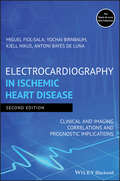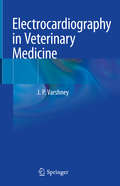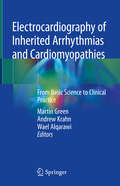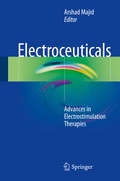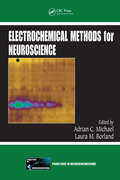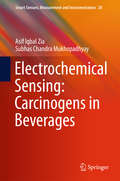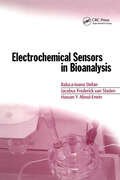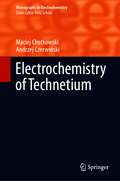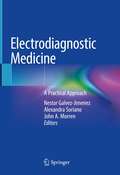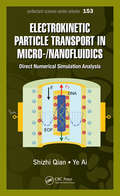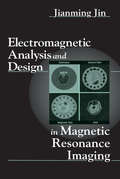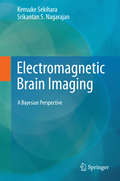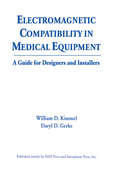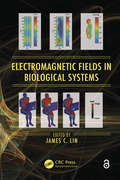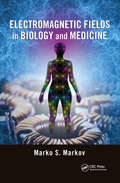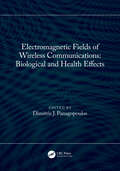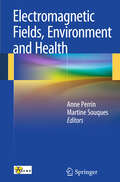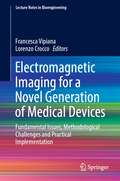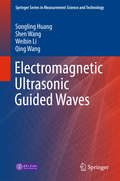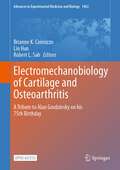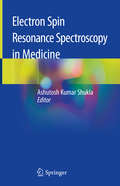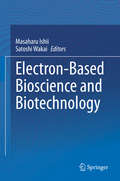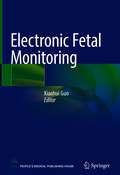- Table View
- List View
Electrocardiography in Ischemic Heart Disease: Clinical and Imaging Correlations and Prognostic Implications
by Antoni Bayés de Luna Miguel Fiol-Sala Yochai Birnbaum Kjell NikusA fresh assessment of ischemic electrocardiography, its prognostic correlations, and the concepts and principles that underlie its use The electrocardiogram (ECG) is integral to the accurate diagnosis and optimal management of patients with ischemic heart disease. Picking up a wide range of indicators, it provides valuable prognostic data to cardiologists and emergency medicine specialists for whom ECG readings are a trusted and everyday resource. Electrocardiography in Ischemic Heart Disease is designed to help enhance such clinicians' understanding of ECG recordings and their relationship to anatomical patterns of myocardial ischemia, thereby facilitating the continued improvement of patient care. For this new edition, the book's globally recognized team of authors has revised and expanded the original text to bring it up to date with the cardiology of today. Practical explanations of electrophysiological mechanisms, ischemic insults, and arterial occlusions are placed in the context of the ECG's day-to-day use, while full-color images illustrate core concepts in a vivid and instructive manner. This essential guide: Demonstrates correlations between ECG recordings and anatomical patterns of myocardial ischemia Covers STEMI, special forms of NSTEMI, and Q waves Describes electrocardiographic patterns of ischemia, injury, and infarction Includes full-color images Explores advanced techniques such as contrast-enhanced cardiac magnetic resonance Electrocardiography in Ischemic Heart Disease is an indispensable resource for both trainee and practicing cardiologists, emergency medicine physicians, and any clinicians involved in the diagnosis and management of ischemic heart disease.
Electrocardiography in Veterinary Medicine
by J.P. VarshneyThis book provides essential information on methodologies for recording electrocardiograms in various animal species, including dogs, cats, cattle, buffaloes, sheep, goats, mithun, chelonians, snakes, avians, equines, rabbits, and the Indian gray mongoose. It also reviews the electrocardiographic physiology, generation of electrocardiograms, and normal criteria for various animal species; electrocardiograms in health and disease; and the interpretation of abnormal electrocardiograms, cardiomyopathy and arrhythmias, with corresponding treatment protocols.Further, it presents several approaches to interpreting the electrocardiograms of dogs, cats, ruminants, tortoises, pigeons, and other animals, offering a valuable resource for all veterinary students, scientists, and physicians wanting to make greater use of this valuable non-invasive tool in the diagnosis of heart diseases and general health examinations.
Electrocardiography of Inherited Arrhythmias and Cardiomyopathies: From Basic Science to Clinical Practice
by Martin Green Andrew Krahn Wael AlqarawiThis book provides a comprehensive review of the ECG findings of inherited arrhythmias and cardiomyopathies. Despite new forms of medical imaging, electrocardiography (ECG) remains the cornerstone of diagnosis, risk-stratification, and prognosis for these conditions. It is extremely important for clinicians to develop the skills required to interpret the ECG correctly as both overdiagnosis and underdiagnosis of these conditions can have a deleterious effect on patients and their families. Each chapter covers a specific condition and highlights typical or critically important ECG findings. Chapters include detailed descriptions of these findings along with pathophysiological mechanisms and clinical vignettes. In addition, the book reviews some normal ECG findings in athletes in order to differentiate some ECG findings from those which may be found in inherited arrhythmia or cardiomyopathy conditions. Electrocardiography of Inherited Arrhythmias and Cardiomyopathies: From Basic Science to Clinical Practice is an essential resource for physicians, residents, fellows, and medical students in cardiology, cardiac electrophysiology, emergency medicine, sports medicine, and primary care.
Electroceuticals
by Arshad MajidThis book covers recent advances in the use of electrostimulation therapies in movement disorders, epilepsy, inflammatory bowel disease, memory and cognition, disorders of consciousness, foot drop, dysphagia, brain injury, headache, heart failure, hearing loss, and rheumatoid arthritis. It describes techniques such as vagus nerve stimulation, deep brain stimulation, and electrical stimulation of the pharyngeal nerve. Electroceuticals: Advances in Electrostimulation Therapies is aimed at clinicians and basic researchers in the fields of neurology, neurosurgery, cardiology and rheumatology.
Electrochemical Methods for Neuroscience (Frontiers in Neuroengineering Series)
by Adrian C. Michael Laura M. BorlandSince the first implant of a carbon microelectrode in a rat 35 years ago, there have been substantial advances in the sensitivity, selectivity and temporal resolution of electrochemical techniques. Today, these methods provide neurochemical information that is not accessible by other means. The growing recognition of the versatility of electrochemi
Electrochemical Sensing: Carcinogens in Beverages
by Asif Iqbal Zia Subhas Chandra MukhopadhyayThisbook describes a robust, low-cost electrochemical sensing system that is able todetect hormones and phthalates - the most ubiquitous endocrine disruptorcompounds - in beverages and is sufficiently flexible to be readily coupledwith any existing chemical or biochemical sensing system. A novel type of silicon substrate-based smart interdigitaltransducer, developed usingMEMS semiconductor fabrication technology, is employed in conjunction with electrochemical impedance spectroscopy to allow real-time detection andanalysis. Furthermore, thepresented interdigital capacitive sensor design offers a sufficient penetrationdepth of the fringing electric field to permit bulk sample testing. The authorsaddress all aspects of the development of the system and fully explain its benefits. The book will be of wide interest to engineers, scientists, and researchersworking in the fields of physical electrochemistry and biochemistry at theundergraduate, postgraduate, and research levels. It will also be highly relevantfor practitioners and researchers involved in the development of electromagneticsensors.
Electrochemical Sensors in Bioanalysis
by Raluca-Ioana Stefan"Covers the most recent methods and materials for the construction, validation, analysis, and design of electrochemical sensors for bioanalytical, clinical, and pharmaceutical applications--emphasizing the latest classes of enantioselective electrochemical sensors as well as electrochemical sensors for in vivo and in vitro diagnosis, for DNA assay
Electrochemistry of Technetium (Monographs in Electrochemistry)
by Maciej Chotkowski Andrzej CzerwińskiThis book provides detailed information on the electrochemistry of technetium compounds. After a brief physico-chemical characterization of this element, it presents the comparative chemistry of technetium, manganese and rhenium. Particular attention is paid to the stability, disproportionation, comproportionation, hydrolysis and polymerization reactions of technetium ions and their influence on the observed redox systems. The electrochemical properties of both inorganic as well as organic technetium species in aqueous and non-aqueous solutions are also discussed. The respective chapters cover the whole spectrum of topics related to the application of technetium in nuclear medicine, electrochemistry of technetium in spent nuclear fuel (including corrosion properties of technetium alloys), and detecting trace amounts of technetium with the aid of electrochemical methods. Providing readers with information not easily obtained in any other single source, the book will appeal to researchers working in nuclear chemistry, nuclear medicine or the nuclear industry.
Electroconvulsive and Neuromodulation Therapies
by Conrad M. SwartzThis is a Pageburst digital textbook; With more than 400 projections presented, Merrill's Atlas of Radiographic Positioning and Procedures remains the gold standard of radiographic positioning texts. Authors Eugene Frank, Bruce Long, and Barbara Smith have designed this comprehensive resource to be both an excellent textbook and also a superb clinical reference for practicing radiographers and physicians. You'll learn how to properly position the patient so that the resulting radiograph provides the information needed to reach an accurate diagnosis. Complete information is included for the most common projections, as well as for those less commonly requested. Comprehensive coverage of anatomy and positioning makes Merrill's Atlas the most in-depth text and reference available for radiography students and practitioners. Essential projections that are frequently performed are identified with a special icon to help you focus on what you need to know as an entry-level radiographer. Full-color presentation helps visually clarify key concepts. Summaries of pathology are grouped in tables in positioning chapters for quick access to the likely pathologies for each bone group or body system. Special chapters, including trauma, surgical radiography, geriatrics/pediatrics, and bone densitometry help prepare you for the full scope of situations you will encounter. Exposure technique charts outline technique factors to use for the various projections in the positioning chapters. Projection summary tables at the beginning of each procedural chapter offer general chapter overviews and serve as handy study guides. Bulleted lists provide clear instructions on how to correctly position the patient and body part. Anatomy summary tables at the beginning of each positioning chapter describe and identify the anatomy you need to know in order to properly position the patient, set exposures, and take high-quality radiographs. Anatomy and positioning information is presented in separate chapters for each bone group or organ system, all heavily illustrated in full-color and augmented with CT scans and MRI images, to help you learn both traditional and cross-sectional anatomy. Includes a unique new section on working with and positioning obese patients. Offers coverage of one new compensating filter. Provides collimation sizes and other key information for each relevant projection. Features more CT and MRI images to enhance your understanding of cross-sectional anatomy and prepare you for the Registry exam. Offers additional digital images in each chapter, including "stitching" for long-length images of the spine and lower limb. Standardized image receptor sizes use English measurements with metric in parentheses. Depicts the newest equipment with updated photographs and images.
Electrodiagnostic Medicine: A Practical Approach
by Nestor Galvez-Jimenez Alexandra Soriano John A. MorrenThis easily readable book describes a practical approach to electrodiagnostic medicine. Replete with well-curated figures, the relevant principles and procedures are clearly described and portrayed, including the anatomical details needed for successful nerve conduction studies and needle electrode examination. Numerous summary tables also convey key information in a concise and easily accessible manner. The reader is also able to reinforce understanding of the various topics through high-yield sample cases which are presented and discussed at the end of chapters. Electrodiagnostic Medicine, A Practical Approach is ideal reading for budding, junior as well as more experienced electrodiagnosticians, particularly those in the field neurology and physiatry.
Electrokinetic Particle Transport in Micro-/Nanofluidics: Direct Numerical Simulation Analysis (Surfactant Science)
by Shizhi Qian Ye AiNumerous applications of micro-/nanofluidics are related to particle transport in micro-/nanoscale channels, and electrokinetics has proved to be one of the most promising tools to manipulate particles in micro/nanofluidics. Therefore, a comprehensive understanding of electrokinetic particle transport in micro-/nanoscale channels is crucial to the
Electromagnetic Analysis and Design in Magnetic Resonance Imaging (Biomedical Engineering Ser. #1)
by Jianming JinThis book presents a comprehensive treatment of electromagnetic analysis and design of three critical devices for an MRI system - the magnet, gradient coils, and radiofrequency (RF) coils. Electromagnetic Analysis and Design in Magnetic Resonance Imaging is unique in its detailed examination of the analysis and design of the hardware for an MRI system. It takes an engineering perspective to serve the many scientists and engineers in this rapidly expanding field.Chapters present:an introduction to MRIbasic concepts of electromagnetics, including Helmholtz and Maxwell coils, inductance calculation, and magnetic fields produced by special cylindrical and spherical surface currentsprinciples for the analysis and design of gradient coils, including discrete wires and the target field method analysis of RF coils based on the equivalent lumped-circuit model as well as an analysis based on the integral equation formulationsurvey of special purpose RF coilsanalytical and numerical methods for the analysis of electromagnetic fields in biological objectsWith the continued, active development of MRI instrumentation, Electromagnetic Analysis and Design in Magnetic Resonance Imaging presents an excellent, logically organized text - an indispensable resource for engineers, physicists, and graduate students working in the field of MRI.
Electromagnetic Brain Imaging
by Kensuke Sekihara Srikantan S. NagarajanThis graduate level textbook provides a coherent introduction to the body of main-stream algorithms used in electromagnetic brain imaging, with specific emphasis on novel Bayesian algorithms. It helps readers to more easily understand literature in biomedical engineering and related fields and be ready to pursue research in either the engineering or the neuroscientific aspects of electromagnetic brain imaging. This textbook will not only appeal to graduate students but all scientists and engineers engaged in research on electromagnetic brain imaging.
Electromagnetic Compatibility in Medical Equipment: A Guide for Designers and Installers
by William D. Kimmel Daryl GerkeCo-published with the IEEE Press, this book is a practical, hands-on guide to EMC issues for medical device designers and installers. It addresses electromagnetic interference and covers the basics of EMC design, physics, and installation, minimizing theory and concentrating upon the correct way to ground and shield. Covering EMC from the inside out, the book provides the basics of electronics, discusses and evaluates problems and common causes, and explores effective remedial techniques at three levels: circuit, box, and interconnect. It contains appendices that provide important reference material such as constants and conversion factors.
Electromagnetic Fields in Biological Systems
by James C. LinSpanning static fields to terahertz waves, this volume explores the range of consequences electromagnetic fields have on the human body. Topics discussed include essential interactions and field coupling phenomena; electric field interactions in cells, focusing on ultrashort, pulsed high-intensity fields; dosimetry or coupling of ELF fields into biological systems; and the historical developments and recent trends in numerical dosimetry. It also discusses mobile communication devices and the dosimetry of RF radiation into the human body, exposure and dosimetry associated with MRI and spectroscopy, and available data on the interaction of terahertz radiation with biological tissues, cells, organelles, and molecules.
Electromagnetic Fields in Biology and Medicine
by Marko S. MarkovThrough a biophysical approach, Electromagnetic Fields in Biology and Medicine provides state-of-the-art knowledge on both the biological and therapeutic effects of Electromagnetic Fields (EMFs). The reader is guided through explanations of general problems related to the benefits and hazards of EMFs, step-by-step engineering processes, and basic r
Electromagnetic Fields of Wireless Communications: Biological and Health Effects
by Dimitris J. PanagopoulosThis book reflects contributions from experts in biological and health effects of Radio Frequency (RF)/Microwave and Extremely Low Frequency (ELF) Electromagnetic Fields (EMFs) used in wireless communications (WC) and other technological applications. Diverse topics related to physics, biology, pathology, epidemiology, and plausible biophysical and biochemical mechanisms of WC EMFs emitted by antennas and devices are included. Discussions on the possible consequences of fifth generation (5G) mobile telephony (MT) EMFs based on available data and correlation between anthropogenic EMF exposures and various pathological conditions such as infertility, cancer, electro-hypersensitivity, organic and viral diseases, and effects on animals, plants, trees, and environment are included. It further illustrates individual and public health protection and the setting of biologically- and epidemiologically-based exposure limits.Features: Covers biological and health effects, including oxidative stress, DNA damage, reproductive effects of mobile phones/antennas (2G, 3G, 4G), cordless phones, Wi-Fi, etc. Describes effects induced by real-life exposures by commercially available devices/antennas. Illustrates biophysical and biochemical mechanisms that fill the gap between recorded experimental and epidemiological findings and their explanations. Explores experimental and epidemiological facts and mechanisms of action. Provides explanations and protection tips. Transcends across physical, biological, chemical, health, epidemiological, and environmental aspects of the topic. This book is aimed at senior undergraduate/graduate students in physics, biology, medicine, bioelectromagnetics, electromagnetic biology, non-ionizing radiation biophysics, telecommunications, electromagnetism, bioengineering, and dosimetry.
Electromagnetic Fields, Environment and Health
by Anne Perrin Martine SouquesA good number of misconceptions are currently circulating on the effects of non-ionizing radiations on our health, which can lead to an oversimplification of the issue, to potentially dangerous assumptions or to misleading data analysis. Health effects may be exaggerated, or on the contrary underplayed. The authors of this work (doctors, engineers and researchers) have endeavored to supply validated and easily understandable scientific information on the electromagnetic fields and their biological and health effects. After a general review of the physics of the waves and a presentation of non-ionizing radiations, the authors review the main emission sources encountered in our daily environment. They summarize simply but as accurately as possible the current knowledge on their biological effects. The safety limits recommended by international organizations are presented for the different frequency ranges. This book is intended for doctors, teachers, scientists, students, policy makers and anyone else interested in a deeper understanding of the health effects of electromagnetic fields. Intended to serve a broad readership, everyone will approach it according to their respective level of curiosity and knowledge. It is neither an exhaustive inventory of all the studies made to date, nor a survey text focusing only on some chosen studies. Nor is the objective to present all the sources of non-ionizing radiations. Interested readers will be given the opportunity to broaden their knowledge, also by consulting the selected bibliography presented by the authors at the end of each chapter.
Electromagnetic Imaging for a Novel Generation of Medical Devices: Fundamental Issues, Methodological Challenges and Practical Implementation (Lecture Notes in Bioengineering)
by Lorenzo Crocco Francesca VipianaThis book offers the first comprehensive coverage of microwave medical imaging, with a special focus on the development of novel devices and methods for different applications in both the diagnosis and treatment of various diseases. Upon introducing the fundamentals of electromagnetic imaging, it guides the readers to their use in practice by providing extensive information on the corresponding measurement and testing techniques. In turn, it discusses current challenges in data processing and analysis, presenting effective, novel solutions, developed by different research groups. It also describes state-of-the-art medical devices, which were designed for specific applications, such as brain stroke monitoring, lymph node diagnosis, image-guided hyperthermia, and chemotherapy response monitoring. The chapters, which report on the results of the EU-funded project EMERALD (ElectroMagnetic imaging for a novel genERation of medicAL Devices) are written by leading European engineering groups in electromagnetic medical imaging, whose coordinated action is expected to accelerate the translation of this technology “from research bench to patient bedside”. All in all, this book offers an authoritative guide to microwave imaging, with a special focus on medical imaging, for electrical and biomedical engineers, and applied physicists and mathematicians. It is also intended to inform medical doctors and imaging technicians on the state-of-the-art in non-invasive imaging technologies, at the purpose of inspiring and fostering the translation of research into clinical prototypes, by promoting a stronger collaboration between academic institutions, industrial partners, hospitals, and university medical centers.
Electromagnetic Ultrasonic Guided Waves
by Qing Wang Songling Huang Shen Wang Weibin LiThis book introduces the fundamental theory of electromagnetic ultrasonic guided waves, together with its applications. It includes the dispersion characteristics and matching theory of guided waves; the mechanism of production and theoretical model of electromagnetic ultrasonic guided waves; the effect mechanism between guided waves and defects; the simulation method for the entire process of electromagnetic ultrasonic guided wave propagation; electromagnetic ultrasonic thickness measurement; pipeline axial guided wave defect detection; and electromagnetic ultrasonic guided wave detection of gas pipeline cracks. This theory and findings on applications draw on the author's intensive research over the past eight years. The book can be used for nondestructive testing technology and as an engineering reference work. The specific implementation of the electromagnetic ultrasonic guided wave system presented here will also be of value for other nondestructive test developers.
Electromechanobiology of Cartilage and Osteoarthritis: A Tribute to Alan Grodzinsky on his 75th Birthday (Advances in Experimental Medicine and Biology #1402)
by Brianne K. Connizzo Lin Han Robert L. SahThis is an open access book. In honor of his 75th birthday, we reflect on the impact of the pioneering work of Alan Grodzinsky and his laboratory. This volume includes in-depth discussions of tissue electromechanics, mechanobiology and biomechanics, and matrix biology in addition to the latest advancements in understanding the pathogenesis, progression and treatment of osteoarthritis. Unique to this volume, we overview decades of groundbreaking research that set the stage for the latest efforts in the field, highlighting the legacy of one researcher and their trainees.
Electron Spin Resonance Spectroscopy in Medicine
by Ashutosh Kumar ShuklaThis book examines various applications of electron spin resonance spectroscopy (ESR) in medicine, covering topics such as interactions between blood and nanoparticles, physical intricacy of HbNO complexes, parasitic diseases, oxidative stress measurement, polymerization of resinous materials used in dentistry, tooth dosimetry and dermatological applications. Instead of providing mathematical details, it focuses on the applications and data interpretation of ESR as an emerging tool. This book is intended for students and researchers interested in the field of ESR applications in translational research and medicine.
Electron-Based Bioscience and Biotechnology
by Masaharu Ishii Satoshi WakaiThis book offers a comprehensive introduction to electron-based bioscience, biotechnology, and biocorrosion. It both explains the importance of electron flow during metabolic processes in microorganisms and provides valuable insights into emerging applications in various fields. In the opening section, readers will find up-to-date information on topics such as electron transfer reactions, extracellular electron transfer mechanisms, direct interspecies electron transfer, and electron uptake by sulfate-reducing bacteria. The focus then shifts to state-of-the-art advances and applications in the field of biotechnology. Here, the coverage encompasses e.g. progress in understanding electrochemical interactions between microorganisms and conductive particles, enzymatic reactions and their application in the bioproduction of useful chemicals, and the importance of redox balance for fatty acid production. In closing, the book addresses various aspects of the complex phenomenon of microbiologically induced corrosion, highlighting novel insights from the fields of electromicrobiology and electrochemistry and their implications.
Electronic Cigarettes and Vape Devices: A Comprehensive Guide for Clinicians and Health Professionals
by Karen Wilson Susan Chu WalleyElectronic cigarettes (E-cigarettes), also known as vape devices or by trade names such as JUUL, are handheld devices that aerosolize liquid commonly containing nicotine, humectants and flavorings. Used by 1 in 5 high school students in 2020, they are the most common tobacco product used by youth. E-cigarette use has been associated with a variety of health issues such as nicotine addiction, e-cigarette or vaping associated lung illness (EVALI), seizures, and increased risk of cardiovascular disease. This first-of-its-kind book begins with an introduction and background on the historical context of tobacco products. The next chapters provide an overview of the e-cigarette landscape and reviews the e-cigarette devices and solutions and the evolution of these products. This is followed by reviews of the health effects of e-cigarettes on users and non-users and includes recommendations for prevention and treatment of youth e-cigarette use. The last few chapters address the public health impact of e-cigarettes with a review of the evidence of e-cigarettes in smoking cessation. The book closes with policy and advocacy approaches and a resource page. E-cigarette and vape device use pose a public health crisis. This book contains succinct practical information and is a key reference for pediatricians as well as clinicians of all specialities. It also serves as a resource for health professionals, including tobacco dependence treatment providers and public health experts.
Electronic Fetal Monitoring
by Xiaohui GuoThis book offers clinicians involved in perinatal care a detailed and in-depth perspective on electronic fetal monitoring (EFM). Topics include EFM management, antepartum and intrapartum fetal assessment and application of EFM in abnormal pregnancy, obstetrical complications, fetal acid-base balance, and fetal arrhythmias. Variant fetal heart rate patterns are presented with interpretation, diagnosis and comments from experts who have wealthy experience in high risk pregnancy intervention. It will be a valuable reference for physicians, nurses, and midwives who are responsible for initiating, performing, and interpreting EFM.
